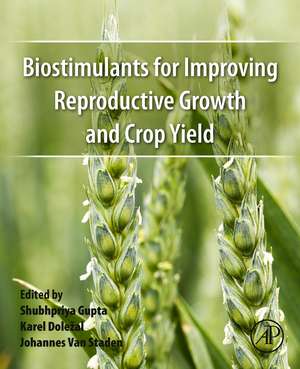Biostimulants for Improving Reproductive Growth and Crop Yield
Editat de Shubhpriya Gupta, Karel Dolezal, Johannes Van Stadenen Limba Engleză Paperback – 29 ian 2025
Biostimulants are a group of substances of natural origin and/or microorganisms that offers the potential to reduce the dependency on harmful chemical fertilizers that cause environmental degradation. The application of biostimulants represents one of the most innovative and promising strategies to improve crop productivity.
- Focuses on the biochemical, physiological, and molecular mode of action of biostimulants
- Includes the effects of both organic and inorganic biostimulants
- Details the role of biostimulants in sexual and asexual reproductive results
Preț: 671.20 lei
Preț vechi: 878.16 lei
-24% Nou
Puncte Express: 1007
Preț estimativ în valută:
128.47€ • 139.60$ • 107.99£
128.47€ • 139.60$ • 107.99£
Carte tipărită la comandă
Livrare economică 14-28 aprilie
Preluare comenzi: 021 569.72.76
Specificații
ISBN-13: 9780443132070
ISBN-10: 0443132070
Pagini: 330
Dimensiuni: 191 x 235 mm
Greutate: 0.52 kg
Editura: ELSEVIER SCIENCE
ISBN-10: 0443132070
Pagini: 330
Dimensiuni: 191 x 235 mm
Greutate: 0.52 kg
Editura: ELSEVIER SCIENCE
Cuprins
1. Evaluating biostimulants and their active biomolecules in improving reproductive growth of crops
2. Application of biostimulants for vegetative reproduction of crops with special reference to bulbs, corms, tubers, rhizomes and stolons.
3. Role of biostimulants in the induction of buds and flowering
4. Influence of biostimulants on pollen germination, pollen tube development and
pollen viability
5. Role of biostimulants in pollen-pistil interaction and development of female gametophyte (ovule development)
6. Effect of biostimulants on fertilization and embryo development
7. Enhancing seed production and quality using biostimulants
8. Effect of biostimulants on fruit set and fruit yield
9. Contribution of biostimulants in improving flower and fruit longevity
10. Role of biostimulants in the regulation of the physiology of flowering
11. Improving crop yield and produce quality using biostimulants
12. Empirical evidence of the efficacy of biostimulants in improving crop productivity under field conditions
13. Common mistakes made by researchers and farmers when applying biostimulants
14. Action mechanisms of biostimulants with respect to reproductive growth (sexual and vegetative reproduction) and crop yield
15. State-of-the-art and future research directions in biostimulant research for improving reproductive growth and crop yield
2. Application of biostimulants for vegetative reproduction of crops with special reference to bulbs, corms, tubers, rhizomes and stolons.
3. Role of biostimulants in the induction of buds and flowering
4. Influence of biostimulants on pollen germination, pollen tube development and
pollen viability
5. Role of biostimulants in pollen-pistil interaction and development of female gametophyte (ovule development)
6. Effect of biostimulants on fertilization and embryo development
7. Enhancing seed production and quality using biostimulants
8. Effect of biostimulants on fruit set and fruit yield
9. Contribution of biostimulants in improving flower and fruit longevity
10. Role of biostimulants in the regulation of the physiology of flowering
11. Improving crop yield and produce quality using biostimulants
12. Empirical evidence of the efficacy of biostimulants in improving crop productivity under field conditions
13. Common mistakes made by researchers and farmers when applying biostimulants
14. Action mechanisms of biostimulants with respect to reproductive growth (sexual and vegetative reproduction) and crop yield
15. State-of-the-art and future research directions in biostimulant research for improving reproductive growth and crop yield
